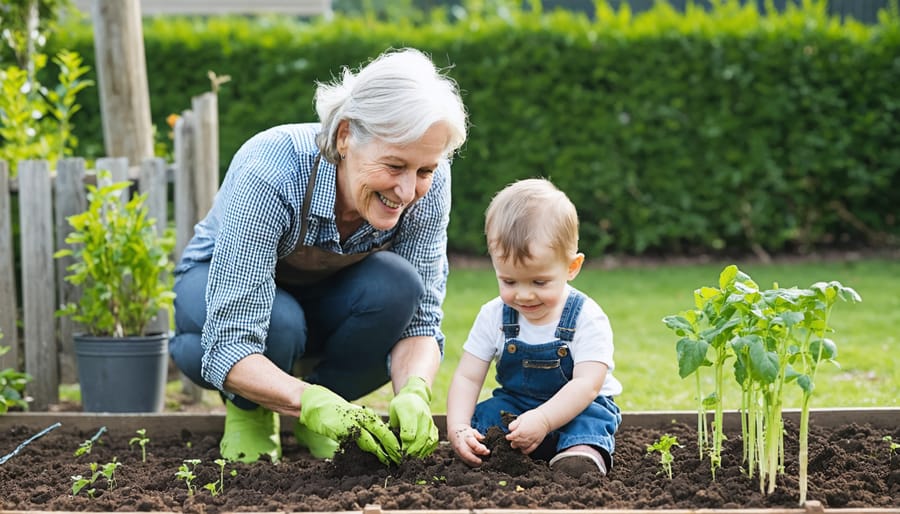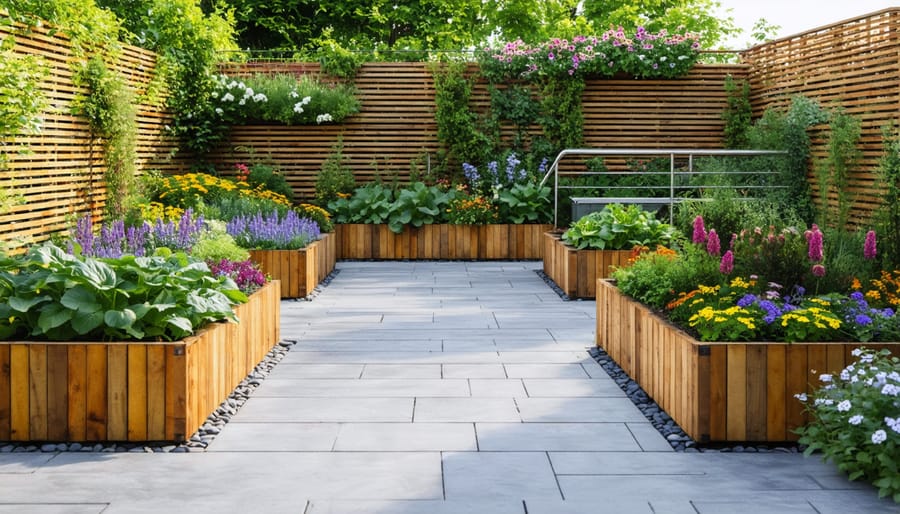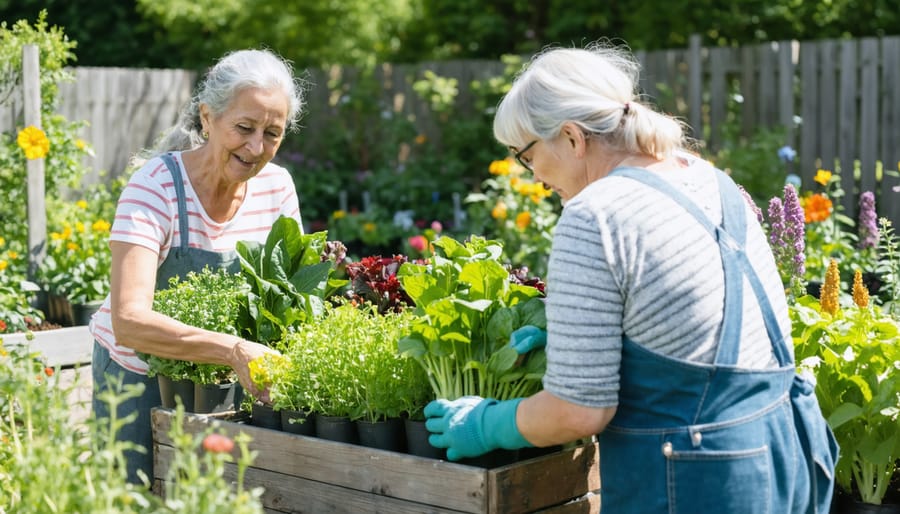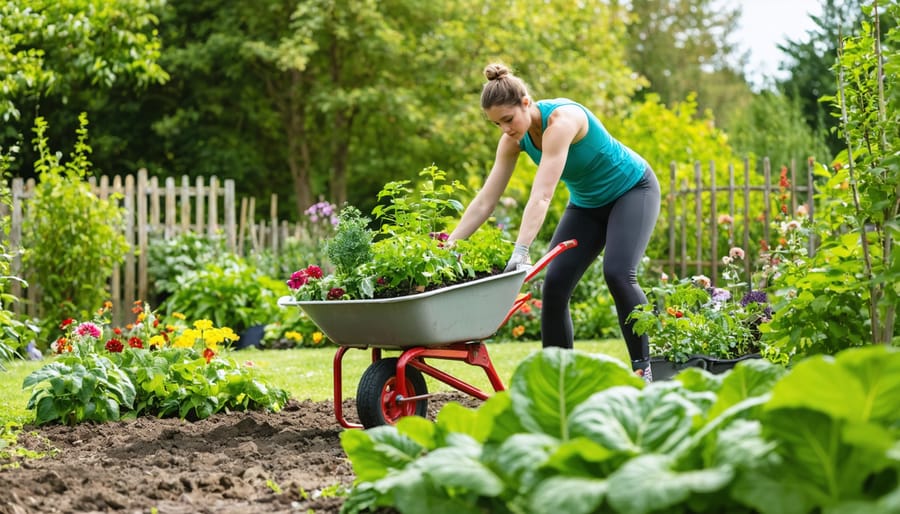Transform an ordinary garden into a wellness sanctuary by planting fragrant herbs like lavender, rosemary, and chamomile in raised beds where both children and seniors can easily access them. Position benches strategically throughout the space, creating natural gathering spots that encourage conversation and shared gardening moments between generations. Design wide, wheelchair-accessible paths with smooth, non-slip surfaces connecting different garden zones, ensuring everyone can participate safely in gardening activities.
Gardening nurtures more than just plants – it cultivates healing connections across generations while boosting physical and mental wellbeing. Research shows that just 30 minutes of gentle gardening reduces stress hormones and increases feel-good endorphins, while the act of nurturing plants alongside others strengthens community bonds and improves cognitive function in both young and old.
From the meditative practice of morning watering to the joy of harvesting home-grown vegetables together, every garden moment becomes an opportunity for growth, learning, and connection. This living classroom offers endless possibilities for sharing knowledge, creating memories, and building a healthier, more connected community – one seed at a time.

The Healing Power of Cross-Generation Gardens
Physical Benefits Across Ages
The physical benefits of gardening extend across all age groups, making it a perfect activity for lifelong wellness. For children, gardening develops gross motor skills through digging, planting, and carrying watering cans. These natural movements help build strength and coordination while fostering a connection with nature.
Adults find gardening to be a complete body workout that combines cardio, strength training, and flexibility exercises. Tasks like weeding, mulching, and pruning engage multiple muscle groups while burning calories. The gentle stretching required for reaching and bending helps maintain joint mobility and prevents stiffness.
For seniors, gardening offers low-impact exercise that can be adapted to different mobility levels. Raised beds and container gardens make it easier to tend plants without excessive bending, while the regular maintenance routine helps maintain balance and dexterity. Even simple activities like deadheading flowers or harvesting vegetables provide purposeful movement that keeps joints flexible and muscles active.
Best of all, these physical activities feel less like exercise and more like enjoyable outdoor time, making it easier to stay consistent with regular movement throughout the seasons.
Mental Health and Social Connection
Gardening offers a powerful antidote to modern life’s stresses, serving as a natural mood booster and anxiety reducer. Research has shown that the simple act of tending to plants can lower cortisol levels, our body’s primary stress hormone. When we connect with nature through gardening, we experience a sense of calm and groundedness that’s particularly valuable in today’s fast-paced world.
The mental health benefits of community gardens extend beyond individual wellness to create meaningful social connections. Whether you’re sharing gardening tips with neighbors, swapping homegrown vegetables, or participating in community growing projects, these interactions foster a sense of belonging and mutual support.
Many gardeners report that their garden becomes a sanctuary for mindfulness and reflection. The rhythmic nature of activities like weeding, watering, and pruning creates a meditative state that helps clear the mind and reduce anxiety. Even better, gardening alongside others can combat feelings of isolation while creating lasting friendships through shared experiences and common interests. It’s a wonderful way to stay connected to both nature and your community while nurturing your mental wellbeing.
Creating an Age-Friendly Garden Space
Accessible Design Features
Creating a healing garden space that welcomes everyone requires thoughtful planning and inclusive design. By following biophilic garden design principles, we can create gardens that are both beautiful and accessible to all.
Start by establishing wide, stable pathways (at least 4 feet across) using non-slip materials like textured concrete or compacted gravel. Include regular resting spots with comfortable seating every 20-30 feet, ensuring benches have sturdy armrests and proper back support.
Raised beds are game-changers for accessibility. Build them 24-36 inches high to minimize bending, and ensure they’re no wider than 4 feet to allow easy reach from either side. Consider U-shaped or L-shaped designs that allow wheelchair users to garden comfortably.
Vertical gardening solutions, like wall-mounted planters and trellises, bring plants within easy reach while maximizing space. Install tool storage at accessible heights and opt for lightweight, ergonomic gardening tools with extended handles.
Good lighting is essential – incorporate solar-powered path lights and ensure high-contrast elements to help with visibility. Include water sources at convenient heights, with easy-to-operate controls and lightweight hoses or watering cans.
Remember to create defined edges along paths and beds to assist those with visual impairments, and include sensory elements like fragrant herbs and plants with interesting textures at various heights.

Safety Considerations
Safety should always be a top priority when creating and maintaining a garden space for multiple age groups. Start by ensuring all tools are properly stored in a locked shed or cabinet when not in use, especially if children will be present in the garden. Choose child-safe tools for younger gardeners, such as plastic trowels and lightweight watering cans.
When selecting plants, be mindful of potentially toxic varieties. Avoid plants with thorns or sharp edges in areas where children play, and clearly mark any plants that shouldn’t be touched or eaten. Create clear pathways between garden beds to prevent tripping hazards, and ensure they’re wide enough for wheelchairs or walkers if needed.
Sun protection is crucial for gardeners of all ages. Encourage everyone to wear broad-brimmed hats, sunscreen, and appropriate clothing. Set up shaded areas for rest breaks, and keep plenty of water available to prevent dehydration during garden activities.
For older gardeners, consider raised beds at comfortable working heights to reduce strain on backs and knees. Use ergonomic tools with padded handles, and place benches strategically throughout the garden for rest stops.
Always supervise young children around water features or ponds, and ensure all garden chemicals and fertilizers are stored safely out of reach. Keep a first aid kit easily accessible, and post emergency contact numbers in a visible location. Remember to wash hands thoroughly after gardening sessions to maintain proper hygiene.
Building Bridges Through Plants
Knowledge Exchange Activities
Intergenerational gardening creates beautiful opportunities for knowledge exchange, bringing together wisdom and fresh perspectives. One effective way to facilitate this exchange is through structured mentorship programs, where experienced gardeners partner with newcomers to share time-tested techniques and traditional growing methods.
Garden clubs can organize regular “wisdom-sharing sessions” where older members demonstrate heritage skills like seed saving, natural pest control, and companion planting, while younger participants contribute their knowledge of modern sustainable practices and technology-based growing solutions.
Hands-on workshops are particularly effective for cross-generational learning. Consider organizing seasonal activities like spring planting days, summer pruning demonstrations, or autumn harvest festivals where different age groups can work together and learn from each other. These sessions can include activities like creating planting calendars, sharing family recipes using home-grown produce, or documenting traditional growing methods through photos and stories.
Community gardens often serve as perfect venues for knowledge exchange activities. Set up regular “garden buddy” programs where experienced gardeners mentor newcomers throughout the growing season. This creates lasting relationships while ensuring valuable gardening knowledge isn’t lost between generations.
Digital documentation can enhance these exchanges, with younger participants helping to record and share traditional growing methods through blogs, social media, or community newsletters. Meanwhile, older gardeners can share their experience-based insights about local growing conditions, weather patterns, and crop timing that aren’t found in gardening books.
Remember to make these activities inclusive and accessible to all ability levels, with plenty of seating, shade, and opportunities for both active and passive participation. This ensures everyone can contribute to and benefit from the collective gardening wisdom being shared.
Cultural Heritage Through Gardening
Gardening has long been a way to preserve and celebrate cultural heritage, passing down traditional knowledge from one generation to the next. Many of today’s popular garden practices have deep cultural roots, from companion planting techniques used by Indigenous peoples to herb gardens inspired by medieval European monasteries.
To incorporate cultural heritage into your garden, start by researching the traditional plants and growing methods of your ancestors or local indigenous communities. Many heirloom varieties carry fascinating stories and have adapted to specific regional conditions over centuries. For example, the Three Sisters method – planting corn, beans, and squash together – is a Native American technique that creates a naturally sustainable growing system.
Consider creating themed garden spaces that reflect different cultural traditions. Japanese zen gardens promote mindfulness and meditation, while Mediterranean herb gardens celebrate culinary heritage. Mexican marigold gardens honor Día de los Muertos traditions, showing how plants can connect us to important cultural celebrations.
Seed saving is another meaningful way to preserve cultural heritage. Many gardeners maintain family varieties that have been passed down through generations, each carrying its own story and significance. By saving and sharing these seeds, you help maintain genetic diversity while keeping cultural traditions alive.
Remember to document your garden’s cultural elements through photographs and written records. Interview older family members about their gardening memories and traditional practices. These stories become valuable resources for future generations, ensuring that cultural knowledge continues to flourish alongside your plants.

Starting Your Community Garden Program
Planning and Organization
Starting a wellness garden requires thoughtful planning to create a space that nurtures both plants and people. Begin by selecting an appropriate location that receives adequate sunlight and has good soil drainage. Consider accessibility – your garden should be easy to reach and navigate, especially if you’re planning to garden with others or have mobility concerns.
Next, assess your available space and create a rough sketch of your garden layout. Include areas for different types of plants, walking paths, and gathering spaces where you can sit and enjoy your garden’s tranquility. If you’re working with limited space, consider vertical gardening options or container gardens.
Make a list of plants you’d like to grow, focusing on varieties that promote wellness. Consider including herbs for aromatherapy, vegetables for nutritious eating, and flowers that attract pollinators. Research each plant’s growing requirements to ensure they’ll thrive in your climate zone.
Gather essential tools and supplies before you begin. Basic items include quality gardening gloves, pruning shears, a trowel, watering can, and organic soil amendments. Start small and expand gradually – this approach helps prevent feeling overwhelmed and allows you to learn as you grow.
Set realistic goals and create a maintenance schedule. Factor in time for daily watering, weekly weeding, and seasonal tasks like mulching and pruning. Remember, gardening should reduce stress, not create it, so plan according to your available time and energy levels.
Sustaining the Program
To keep your wellness garden thriving year after year, it’s essential to develop sustainable habits and routines that work with your lifestyle. Start by creating a simple maintenance calendar that breaks down tasks into manageable daily, weekly, and monthly activities. This prevents overwhelm and helps you stay consistent with garden care.
Consider incorporating time-saving techniques like mulching to reduce watering needs and suppress weeds. Installing a drip irrigation system can automate watering, making it easier to maintain your garden even during busy periods. Remember to rotate your crops and practice companion planting to maintain soil health naturally.
Building a support network is crucial for long-term success. Join local gardening groups or online communities where you can share experiences, exchange tips, and find motivation when challenges arise. These connections often lead to seed swaps and shared resources, making gardening more sustainable and economical.
Document your garden’s progress through photos or a journal. This helps you track what works well and what needs adjustment, while also providing a source of inspiration during off-seasons. Consider involving family members or friends in garden activities – sharing the workload makes maintenance more manageable and enjoyable.
Finally, be flexible and willing to adapt your garden plans based on your changing needs and energy levels. It’s better to maintain a smaller, thriving garden than to feel overwhelmed by a larger space that becomes difficult to manage.
As we’ve explored throughout this article, intergenerational gardening offers a remarkable pathway to wellness that spans far beyond the simple act of growing plants. From strengthening family bonds and fostering community connections to improving physical health and mental well-being, the benefits of creating a shared garden space are truly transformative.
Whether you’re a grandparent looking to share your gardening wisdom, a parent seeking meaningful activities for your children, or someone passionate about bringing your community together, starting an intergenerational garden project is a rewarding endeavor that pays dividends for years to come. The joy of watching young hands plant their first seeds, the pride in seeing elderly gardeners share decades of knowledge, and the satisfaction of harvesting together create memories that last a lifetime.
Remember, you don’t need a vast space or expert knowledge to begin. Start small, perhaps with a few containers or a modest raised bed, and let your garden grow naturally alongside the relationships it nurtures. The most important elements are enthusiasm, openness to learning from each other, and a willingness to get your hands dirty together.
Take that first step today. Plant a seed, invite a neighbor, or reach out to local community centers. Your garden will become more than just a plot of earth – it will grow into a living legacy of health, happiness, and connection across generations.




